
Johannes Nikolaus Tetens
 المؤلف:
...
المؤلف:
...
 المصدر:
Biography in Encyclopaedia Britannica
المصدر:
Biography in Encyclopaedia Britannica
 الجزء والصفحة:
...
الجزء والصفحة:
...
 27-3-2016
27-3-2016
 1334
1334
Born: 16 September 1736 in Tetenbüll (near Tönning), South Schleswig (now Germany)
Died: 17 August 1807 in Copenhagen, Denmark

Johannes Tetens was professor of physics at Bützow University (1760-1765) then was made director of the Bützow Pädagogium in 1765. He was appointed professor of philosophy at the University of Kiel in 1776 and he was later appointed to the chair of mathematics at Kiel. However, Tetens decided to give up an academic life in 1789 and to offer his services to public life. He first became an assessor but then he was appointed councillor of state and deputy in the Danish Ministry of Finance in Copenhagen.
Tetens' major academic work was in philosophy. He wrote Philosophische Versuche über die menschliche Natur und ihre Entwickelung (Philosophical Experiments on Human Nature and Its Development) (1777), which is an investigation of the origin and structure of knowledge. This was certainly influenced by Kant's 1770 dissertation, but, on the other hand, Teten's work itself was a major influence on Kant and that influence shows up clearly in Kant's Critique of Pure Reason (1781). Empirical foundations for philosophical studies were of great importance to Tetens and Kant is clearly seen to reiterated some of Tetens' arguments in his famous 1781 masterpiece.
Slightly earlier, Tetens had published Über die allgemeine spekulativische Philosophie (On General Speculative Philosophy) (1775). His work in philosophy is rather unusual for a German philosopher, having connections with ideas from both the British and French Schools. In particular he expressed some similar views to the Scottish philosopher David Hume (1711-1776).
In 1786 Tetens introduced ideas which began progress towards a stochastic approach to life insurance mathematics. Keiding writes [2]:-
The method of expected number of deaths is an integral part of standardization of vital rates, which is one of the oldest statistical techniques. The expected number of deaths was calculated in 18th century actuarial mathematics (Tetens, 1786) but the method seems to have been forgotten ...
What Tetens showed was that, given an insurance portfolio with n policies, the risk to the portfolio increases with n, but the risk to an individual policy decreases in proportion to √n. There are random fluctuations in mortality which create a risk to the portfolio but a smoothing effect takes place with increasing n which reduces the risk to individuals.
- Biography in Encyclopaedia Britannica.
http://www.britannica.com/EBchecked/topic/588869/Johannes-Nikolaus-Tetens
Articles:
- N Keiding, The method of expected number of deaths, 1786-1886-1986, Internat. Statist. Rev. 55 (1) (1987), 1-20.
 الاكثر قراءة في 1700to1749
الاكثر قراءة في 1700to1749
 اخر الاخبار
اخر الاخبار
اخبار العتبة العباسية المقدسة


